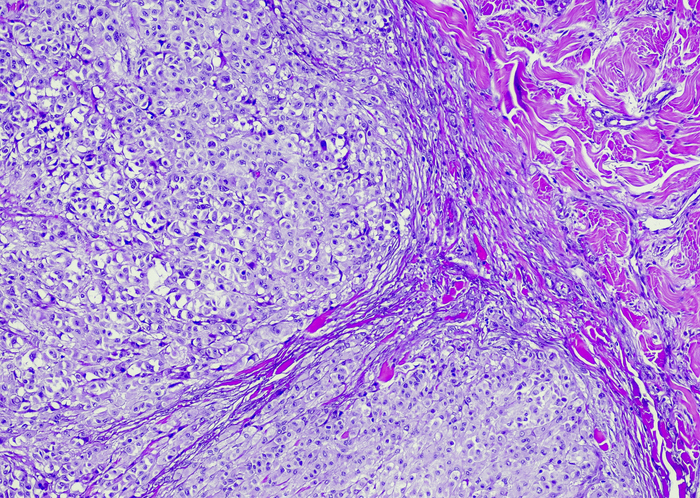
Each week on DocWire News, editors bring you the latest in oncology news and cancer research. In case you missed it, here are this week’s top headlines:
- Sustained Benefit of Cytarabine Conditioning in Younger MCL Patients Undergoing Transplant
- Sulfur Microbial Diet May Increase Risk for Colorectal Cancer
- Many Hospitals Lack All-Trans Retinoic Acid for Treating Leukemia
- Cervical Cancer Incidence Varies by Neighborhood Wealth
Keep reading for the breakdown on these top stories.
RELATED: Last Week’s Round-Up: New FDA Approval in Ovarian Cancers
Sustained Benefit of Cytarabine Conditioning in Younger MCL Patients Undergoing Transplant
Five-year follow-up data from the phase III MCL Younger trial found a sustained benefit associated with high-dose cytarabine conditioning prior to autologous stem cell transplantation (ASCT) in patients with mantle cell lymphoma (MCL) who received induction therapy with chemoimmunotherapy.
In the initial analysis, five-year time to treatment failure (TTF) was significantly greater in the cytarabine conditioning arm than the control arm. At the 2021 ASH Annual Meeting, lead author Olivier Hermine, MD, PhD, from the University of Paris in France, shared long-term follow-up data from a median follow-up of 11 years. At longer-term follow-up, the difference in TTF was still significant in favor of the experimental arm (hazard ratio [HR] = 0.59; P = 0.038), the researchers reported.
https://www.docwirenews.com/conference-coverage/ash-conference-coverage/ash-cll/sustained-benefit-of-cytarabine-conditioning-in-younger-mcl-patients-undergoing-transplant/
Sulfur Microbial Diet May Increase Risk for Colorectal Cancer
Greater adherence to a sulfur microbial diet is associated with an increased risk for colorectal cancer (CRC) in both men and women, according to a study published in JAMA Network Open.
Researchers investigated the association between diet and sulfur-metabolizing bacteria in the development of CRC. The analysis included 214,797 participants from the Health Professionals Follow-up Study (1986 to 2014), Nurses’ Health Study (1984 to 2016), and Nurses’ Health Study II (1991 to 2017) who were free from inflammatory bowel disease and cancer at baseline; a subsample of participants provided stool samples. The researchers found that prospectively, there were 3,217 incident cases of CRC (1.5 percent).
A sulfur microbial diet in a subsample of 307 men and 212 women was characterized by high intakes of low-calorie beverages, French fries, red meats, and processed meats and low intakes of fruits, yellow vegetables, whole grains, legumes, leafy vegetables, and cruciferous vegetables. Greater adherence to the sulfur microbial diet was associated with an increased risk for CRC when adjusting for other factors.
https://www.docwirenews.com/docwire-pick/hem-onc-picks/sulfur-microbial-diet-may-increase-risk-for-colorectal-cancer/
Many Hospitals Lack All-Trans Retinoic Acid for Treating Leukemia
Many hospitals that care for patients with acute leukemia do not have all-trans retinoic acid (ATRA) in stock, according to a study published in the Journal of the National Comprehensive Cancer Network.
The researchers found that 31% of the hospitals analyzed had ATRA in stock. ATRA availability was not influenced by size of the hospital or by hospital status as academic versus nonacademic (53% versus 31%). Only 14% of the hospitals that referred patients with APL had ATRA readily available. Compared with referring centers, hospitals that treated patients with APL were more likely to have ATRA available (58% versus 14%).
https://www.docwirenews.com/docwire-pick/hem-onc-picks/many-hospitals-lack-all-trans-retinoic-acid-for-treating-leukemia/
Cervical Cancer Incidence Varies by Neighborhood Wealth
Cervical cancer incidence varies significantly between poor and wealthy New York City neighborhoods, according to a study published in JAMA Oncology.
The researchers found that age-standardized cervical cancer incidence rates varied across neighborhoods, ranging from 4.4 to 14.7 cases per 100,000 woman-years. Neighborhood socioeconomic status (SES) index was strongly associated with cervical cancer incidence, with women residing in the lowest-SES neighborhoods 73 percent more likely to develop cervical cancer than those in the highest-SES neighborhoods, when adjusting for age, corresponding to incidence rates of 11.2 and 6.5 cases per 100,000 woman-years, respectively.
https://www.docwirenews.com/urban-health-today/urban-health-picks/cervical-cancer-incidence-varies-by-neighborhood-wealth/
Want to see more oncology news?
Check out last week’s Round-Up, and be sure to keep up with the latest oncology news and cancer research here on DocWire, updated daily!







 © 2025 Mashup Media, LLC, a Formedics Property. All Rights Reserved.
© 2025 Mashup Media, LLC, a Formedics Property. All Rights Reserved.